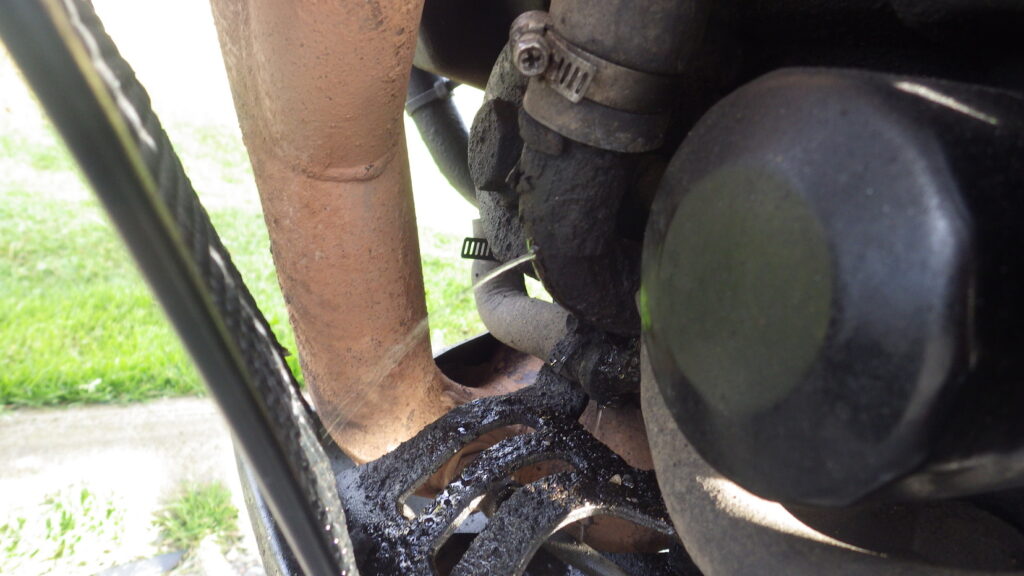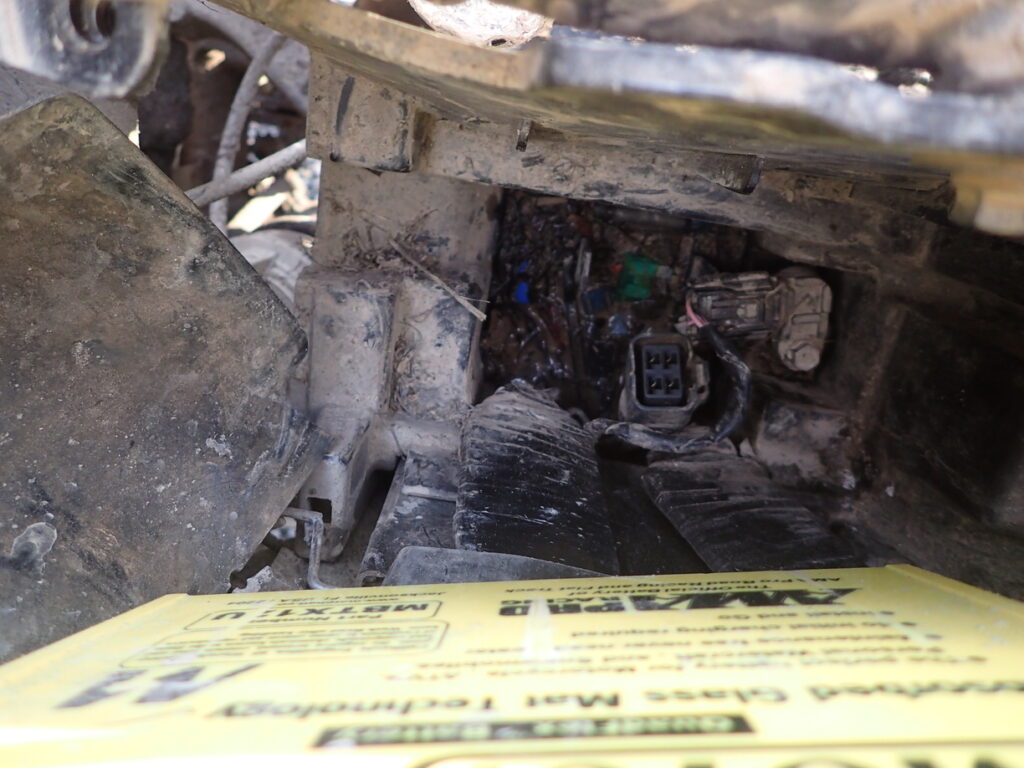Here’s a load of info about the Tiger 800. I’ve got a 2012 one, so this is mostly about that shape, but I’ve noted where I know things are irrelevant to the new ones. Expect this to change as I find things. :)

I’ve a manual, data sheet and service schedule for the bike (pre-2015), here:
- http://avi.st/s/Tiger_800_Service_Manual.pdf
- http://avi.st/s/Tiger_800_Data_Sheet.pdf
- http://avi.st/s/Triumph_Service_Schedule.pdf
And, thanks to Matt McLelland, there’s a manual for the 2016-on ones here:
If you’re looking for exploded diagrams and genuine parts, Fowlers are good for those. World Of Triumph also have exploded diagrams, but they use their own part numbers and don’t warn you of things not being in stock before you order them.
Muddy Sump is generally taken as the go-to for tutorials on how to work on the bike. He’s also a roving mechanic, who’ll come to your house and fix your bike (in the UK).
I don’t know how to tell which OBD readers work on the Triumphs, but what I use is apparently a ‘mini ELM327 OBD2 v1.5’. I’ve heard that OBD v2.x readers will not work, because the Triumph ECU doesn’t support the negotiation. I use the Torque app on my phone to read the data.
I’ve replaced the mirrors on mine with natty folding ones that Wemoto reckon are for a KTM 950. They solve more problems for me than the fantastically expensive Double-Takes, and only cost £15.
It’s a great bike for all the reasons the reviews generally go on about, but there’s a couple of nice little touches that are often missed:
- The XC and roadie cockpits are interchangeable, so you can raise/lower the bars by swapping risers, and get the same-shaped wider or narrower bars by swapping those. Tiger 1200 bars are a common switch, too.
- It is approximately balanced on the centrestand with no luggage – you can stably tip it on to either wheel, and can remove either wheel without needing anything to prop the other end up.
Numbers
| Front axle allen key | 17mm |
| Rear axle nut | 27mm (12mm & 13mm for the chain adjusters) |
| Chain slack | Roadie: 15 – 25mm XC: 20 – 30mm |
| Spark plug | NGK CR9EK – 16mm socket |
| Front brake pads | EBC: FA226 Ferodo: FDB570 OE: T2020377 |
| Rear brake pads | EBC: FA140 Ferodo: FDB531 OE: T2020602 |
| Oil | 3.6L 10w40 |
| Coolant | ~2.5L OAT |
| Front tyre | Roadie: 110/80 19 or 110/90 19 XC: 90/90 21 |
| Rear tyre | 150/70 17 |
Common Problems
It’s not without its flaws, though. Here’s a list of issues I’ve had/noticed:
- The starter tends to fail relatively quickly (20-30K miles). The 675 engine uses the same part, and Speed Triple ones are often cheaper than those from another Tiger. The problem is the brushes wearing out very quickly, and it looks and feels like a flat battery. The problem, really, is high load (from the poor contact) rather than a flat battery. Not-fixing this for a bit does tend to ruin the battery though. Generally, this is more of a problem on warm engines; left for a couple of hours (or overnight) mine would start immediately. This is fixed on the 2016-on bikes, so those are also a good source of starter for the 2012-15 ones.
- The throttle idle stepper motor stops working if it gets excessively dusty, and it’s not the sort of thing you normally clean. It’s basically the replacement for the idle screw on a carb, and there are people who’ve converted this to use the Daytona’s manual adjuster. It’s easiest sorted with the tank and top of the airbox off (do it when changing the air filter), but you can get a solvent spray on it without taking the tank off when you know where it is – I doused mine with GT-85 at about 20K and as of this writing (60K) it’s been fine. It doesn’t stop the bike working, just means it doesn’t idle. The stepper-motor doesn’t exist on the post-15 bikes (the three-letter ones, XCX, XCA, XRX, XRT) so can’t be a problem there.
- The stock suspension on the roadie is terrible off-road (really over-damped) and the XC’s variously regarded as a bit better or sorted. Andreani make a cartridge kit for ~£500 (brexit might change this) which adds adjustment, and completely sorted it out for me; they’ve no UK importer so I bought from Italian Ebay. The WP stuff on the post-15 bikes is generally regarded as sorted.
- There’s a load of stuff hanging out the front of the engine at the bottom, which is a bit of a dirt-collector and makes it all a bit likely to rot (hence the leak). R&G will sell you a mesh protector for it, but that’ll only stop rocks, really. It’s worth covering the jubilee clips in inner-tube, and generally keeping all that clean. The XC’s bashguard is much more protective, but the whole area does still get dirty.

- The main fuse is underneath the battery, which makes it tricky to replace on an unlit road in the dark when it’s raining etc. The ancillary fuses are easy to get at (under the rider’s seat, by the battery) and there’s gaps for spares. The main fuse is a normal car-sized 30A blade fuse, the rest are micro blade fuses.
- If you blow the headlight fuse, the bike won’t start; I think this is part of a ‘safety’ circuit.
- When refilling the coolant, be really patient and do all the burping, and still expect airlocks. I don’t know why, but the bike seems prone to them. Also, don’t forget about the bleed screw on the top-right of the radiator.
- There’s basically no sealing of the underseat area – it just fills with mud if you ride in the wet, and with dust if you ride in the dry. It’s also possible to eventually drown the battery and main fuse like this so you need to check this (and clear the drain hole) periodically; the relays are on the way down for the mud and dirt, too, so it’s worth cleaning those, too. Mine drowned after 56K of neglect.

- The clutch cable rubs on and eventually through the upper fork leg. I’ve heard of people getting these replaced under warranty. and of other people being refused it.
- The rear shock linkage is the lowest point on the bike, just sort-of dangling there waiting to get twatted by a rock. I’ve not seen a bashplate that’ll protect it.
- The downpipes sometimes rot really quickly (mine had holes in at 45K); Triumph seem aware of this; mine were replaced under (but out of) warranty.
- Nobody makes a folding rear brake lever for it
- The bit of the frame that sticks out the front and holds the headlight unit is welded to the frame and bolted to the lights, so a front-end impact’s likely to write-off the frame.